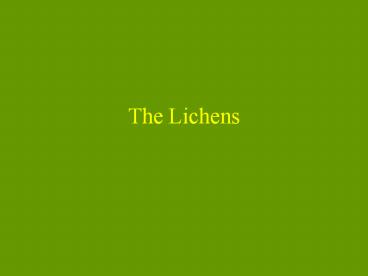The Lichens
1 / 22
Title: The Lichens
1
The Lichens
2
Where do lichens belong in the classification of
living organisms?
Lichens are dual organisms, so they are
difficult to place in a classification They
represent symbiotic (mutualistic) relationships
between fungi and green algae, fungi and
cyanobacteria, or fungi and both The fungus is
the dominant physical component of the lichen
thallus, and lichens are usually classified with
the fungi Nevertheless, the association appears
to have originated through fungi parasitizing
algae and/or cyanobacteria
3
The two components can be separated and grown
independently
Isolation of fungus (Richardson)
Fungus and alga in culture (Richardson)
4
Functional Aspects of the Symbiosis
What does the fungus gain from the alga?
Richardsons summary of movement of carbohydrate
from Trebouxia to fungus
Where cyanobacteria are present, the fungus also
acquires nitrogen
What does the alga gain from the fungus? A
substrate and stable environment Mineral
nutrients ??
5
SEMs of reconstitution of a lichen (Cladonia
cristatella British Soldier) (from Raven)
(a) Trebouxia cell surrounded by fungal
hyphae (b) Penetration by haustorium (see
arrow) (c) Mixed components developing into
mature lichen
(a)
(b)
(c)
6
Identity of the mycobiont and phycobiont
Each of approximately 20,000 known species of
lichen is assumed to have its own unique
mycobiont Most mycobionts are Ascomycetes,
although about twenty lichenized Basidiomycetes
are known In 90 of the lichens, the phycobiont
is a green alga of the genus Trebouxia,
Pseudotrebouxia or Trentepohlia Where
cyanobacteria are involved, they are Nostoc or
Anaboena Lichen-forming fungi rarely grow alone
in nature, while the algal components frequently
do Algae and cyanobacteria grow faster when NOT
part of a lichen
7
Main thallus forms in lichens
Crustose
Foliose
Fruticose
Squamulose, with fruticose podetia
Less commonly, lichens are sorediate or gelatinous
8
Thallus Structure
Cross-section of thallus of Parmelia (foliose
lichen)
Upper cortex
Algal layer
Medulla
Lower cortex
9
Structural features of lichens (Scagel)
A. Thallus with black cephalodia B. Closeup of
cephalodia C. Vertical section through cephalodium
A. Isidia on upper surface B. Isidia in section
Isidia (coral-like outgrowths) of Lobaria
Cephalodia (warty epiphytic lichens) on Peltigera
10
A. Cyphella (cup-shaped depression of
non-gelatinized hyphae) in lower cortex of
Sticta B. Pseudocyphella (small pore forming
white dot) in lower cortex of Sticta
More structural features of lichens - cyphellae
pseudo-cyphellae
11
Asexual reproduction in lichens
Fragmentation of thallus when dry and brittle
Detachment of isidia Loose dusty masses of
soredia Pycnidia
A. Soredia bursting through thallus of Lobaria B.
External view of sorediate mass
Pycnidium of Lecanora
12
Sexual Reproduction in Lichens
Only the fungal partner undergoes sexual
reproduction In the ascomycetous (i.e. most)
lichens, ascospores are formed in sacs called
asci, mixed with paraphyses to form a hymenium.
Asci can be arranged on an open or convex or
concave disk, when it is called an APOTHECIUM,
or in an immersed, urn-shaped PERITHECIUM.
Apothecium (Scagel)
Perithecium (Scagel)
13
Podetia
A podetium is a specialized structure that raises
the apothecia above the rest of the thallus
Cladonia cristatella (British Soldiers)
Cladonia deformis
Cladonia verticillata
14
Growth of Lichens
Growth is very slow 0.1 - 10 mm in crustose
lichens 2-4 cm in some fruticose lichens Some
crustose lichens have been estimated to be over
4,000 years old
15
Lichens in the food chain
Species of Cladonia and Stereocaulon paschale
form a major winter food source for subspecies
and varieties of Rangifer tarandus (e.g. caribou
in N. America and Reindeer in Europe) Other
deer, such as Roosevelt elk and black-tailed deer
of Western Canada, and the musk-oxen of the high
arctic, graze on lichens in the winter A
number of mites and insect larvae feed on
lichens A number of snails and periwinkles also
feed on lichens
16
Other uses of lichens by animals
Birds nest building material and camouflage
Nest of long-tailed titmouse made of lichen in
the UK (Richardson)
Insect camouflage
Mimicry
Lichen-covered lacewing larva
Scalloped hazel moth caterpillar
17
Human Uses of Lichens
Brown, purple and red fabric dyes (e.g.
Scottish tweeds and tartans) Indicators and
stains (e.g. litmus and orcein) Emergency
foods, e.g. rock tripe (Umbilicaria) Part of
the daily diet, e.g. Lecanora esculenta
(manna?) in Iran, flour from Cetraria islandica
(Iceland moss) in Scandinavian ships biscuits,
Inuit nirukkaq - partly digested lichens from
caribou muskox stomachs in winter Commercial
production of sugar in Russia, WWII Iwatake
(Umbilicaria esculanta) as delicacy in Japan
Food additive io retard spoilage
18
More uses of lichens - medicine, embalming and
perfumery (see Richardson for details)
Many lichen extracts are inhibitory to the
growth of Gram-positive bacteria Some are also
effective against Mycobacterium tuberculosus
Oakmoss (Evernia prunastri) and Treemoss
(Pseudoevernia furfuracea) are used in Europe to
make fixatives for perfumes and soaps. The
antibiotic properties of lichens were exploited
by the ancient Egyptians in their embalming
procedures
19
Lichens and Weathering of Rocks
Vertical section of Lecidea apothecium showing
arching of shale laminae (Richardson)
Lichen Acids
20
Some Crustose Lichens
Caloplaca saxicola (Medlin)
Xanthoria elegans (Medlin)
Rhizocarpon geographicum
(map lichen) (Medlin)
21
Some Foliose Lichens
Pulmonaria lobata, Medlin
Cetraria arenaria, Medlin
Parmelia sulcata, Medlin
Peltigera canina, Medlin
22
Some Fruticose Lichens
Cladina rangiferina, Brodo
Cladina stellaris, Medlin
Teloschistes chrysophthalmus
Usnea hirta, Medlin































